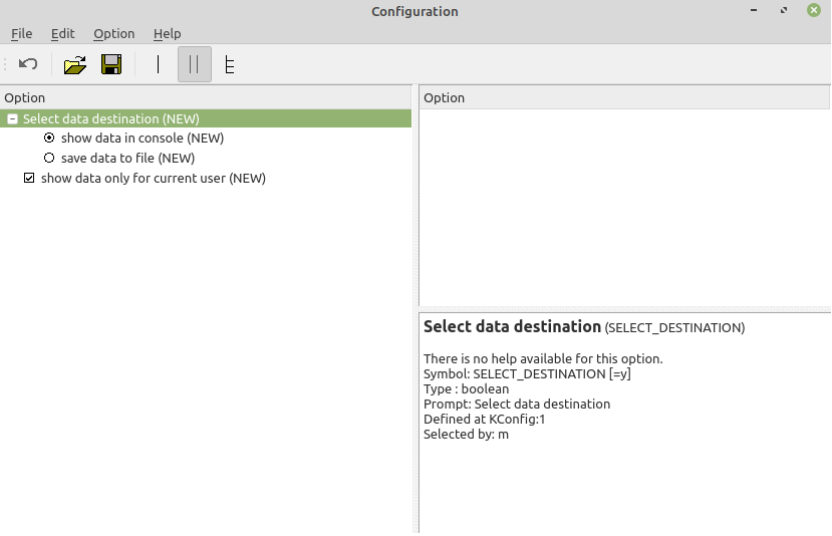Using kconfig for own projects
2023-06-06 https://www.cnblogs.com/NJ-Leon/
Intro
Every Linux professional write scripts. Someеimes light, linear. Sometimes complex script with functions and libs(yes, you can write your bash-library for use in other scripts).
But some of the scripts need a configuration file to work. For instance, I wrote a script that builds the ubuntu image for pxe, and I need to change the build process without build-script changes. The best way to resolve this task is to add configuration files.
Writing this config by hands is not a great idea:
- every user should know all available options
- hight risk of incorrect data entry
- uncomfortable
- maybe something else
Linux kernel gave us a great solution — KConfig. This system resolves all these troubles:
- New config generated automatically
- You can set the default value
- The previous version of config saved automatically
- text/graphical interface available
These are not all the benefits. You can see more here.
How it works
Simplified schema:
- All configuration parameters described in KConfig-format file (including available ones)
- Interpreter (mconf, gconf, qconf, others) reads this file, current config (if it exists), and shows the menu
- The user selects needed options and selects the SAVE option
- KConfig moves old config to .config.old and creates new config (default name .config)
After that, you get a ready-made config that can be used in scripts(or for project build).
Example project
Now, I'll show you the demo-project. I placed it on github.
overview
It's a simple script that shows the information about the last logins. Available options:
- Select destination (file or console)
- If the selected destination is a file, the user can set the filename
- Shows information about both all and only current users
Just clone this repo and go to its directory:
boozlachu@debian:~$ git clone https://github.com/skif-web/demo-kbuild.git Cloning into 'demo-kbuild'... remote: Enumerating objects: 8, done. remote: Counting objects: 100% (8/8), done. remote: Compressing objects: 100% (6/6), done. remote: Total 8 (delta 0), reused 5 (delta 0), pack-reused 0 Unpacking objects: 100% (8/8), done. boozlachu@debian:~$ cd demo-kbuild/ boozlachu@debian:~/demo-kbuild$ ls getLast.sh KConfig README.md
KConfig interpreter notes
KConfig is just a language. You have to use the interpreter to show the menu. In the Linux kernel, the interpreter is built when you run the "make menuconfig" command. But I'm a lazy potato and will use the kconfig-frontends package. It is available in Debian/Ubuntu, and you can also build it from the source. Or add an interpreter build from source to your project.
KConfig file
The main file here is KConfig. KConfig supports a lot of operators, but I'll use only some of them.
Various types of variables are available there. The most useful are:
- string to save string data
- bool to save the bool value (y or commented string in config)
- tristate (*/m/commented)
boozlachu@debian:~/demo-kbuild$ cat KConfig choice SELECT_DESTINATION prompt "Select data destination" default DESTINATION_TTY config SELECT_DESTINATION_TTY bool "show data in console" config SELECT_DESTINATION_FILE bool "save data to file" endchoice config SELECT_DESTINATION_FILE_FILENAME string "destination file" depends on SELECT_DESTINATION_FILE default "last.log" help Write destination file with relative or full path config SHOW_ONLY_CURRENT_USER bool "show data only for current user" default y help script will get data only for current user
Let's see it. Choice-endchoice pair allows creating SELECT of variants. Inside these keywords, I set definition (prompt), default value (default), and added available variants (SELECT_DESTINATION_TTY, SELECT_DESTINATION_FILE).
The next option (SELECT_DESTINATION_FILE_FILENAME) will only be shown if the destination is the file. The keyword "depends on" allows us to do this. Also, the available keyword "selects" that works in the opposite direction.
Option SHOW_ONLY_CURRENT_USER will always be shown.
Run kconfig in text mode:
boozlachu@debian:~/demo-kbuild$ kconfig-mconf KConfig

And with qt:
boozlachu@debian:~/demo-kbuild$ kconfig-qconf KConfig

Test run
After configuring it, we get .config file with options:
boozlachu@debian:~/demo-kbuild$ cat .config # # Automatically generated file; DO NOT EDIT. # Configuration # CONFIG_SELECT_DESTINATION_TTY=y # CONFIG_SELECT_DESTINATION_FILE is not set CONFIG_SHOW_ONLY_CURRENT_USER=y
As you can see, non-selected options are commented on. It's useful for my script.
I run it with this config:
boozlachu@debian:~/demo-kbuild$ ./getLast.sh boozlach pts/0 192.168.2.4 Sun Jul 19 06:00 still logged in boozlach pts/0 192.168.2.4 Sun Jul 19 05:58 - 05:58 (00:00) wtmp begins Thu Apr 16 05:48:31 2020
I changed the parameters via KConfig and got another result. Now the date was saved to a file, instead of being shown in the console:
boozlachu@debian:~/demo-kbuild$ cat .config # # Automatically generated file; DO NOT EDIT. # Configuration # # CONFIG_SELECT_DESTINATION_TTY is not set CONFIG_SELECT_DESTINATION_FILE=y CONFIG_SELECT_DESTINATION_FILE_FILENAME="last.log" CONFIG_SHOW_ONLY_CURRENT_USER=y boozlachu@debian:~/demo-kbuild$ ./getLast.sh boozlachu@debian:~/demo-kbuild$ cat last.log boozlach pts/0 192.168.2.4 Sun Jul 19 06:00 still logged in boozlach pts/0 192.168.2.4 Sun Jul 19 05:58 - 05:58 (00:00)
Conclusion
As you can see, KConfig is very powerful and friendly util for configuring. It can be used for scripts, package building, and other variants.
If you want to see an improved variant of KConfig using a makefile in the real project — write in comments.





